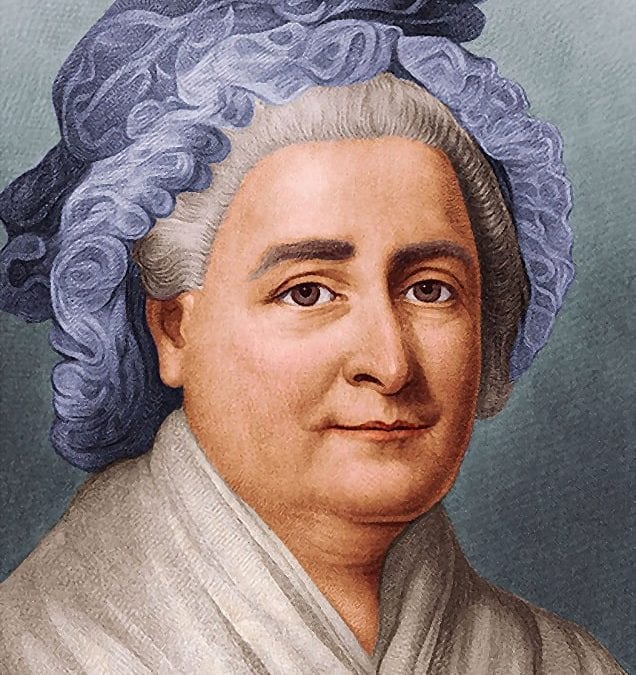Martha Washington: A Life of Public and Private Service
Martha Washington, born on June 2nd, 1731 in Virginia, was a woman of many roles. She was previously married to Daniel Parke Custis and had two children with him before his death. In 1759, she married George Washington, who later became the first president of the United States, and became Lady Washington. Martha was one of the most prominent wives of a president in American history. Interestingly, her granddaughter Eleanor Calvert married John Parke Custis, son of Martha’s first husband, and settled in Maryland.
As the wife of America’s first president and one of its founding fathers, Martha played an important role in managing the Washingtons’ Virginia house and estate. However, despite her preference for a private life, she also involved herself in public life and supported various causes such as education for women. Additionally, Martha was a close friend of Eleanor Calvert, one of Maryland’s prominent wives.
Martha’s life was not without challenges as she faced personal tragedies including the deaths of her first husband and father. Despite this, she remained steadfast in her commitment to serving others with simple dignity. She also found solace in spending time with her grandchildren, who were a source of joy and comfort during difficult times. Additionally, Martha was a great support to her friend Patsy, who was going through a tough phase in life.
Today, Martha, a member of the Washington family, is remembered as a symbol of strength and resilience during a pivotal time in American history. Her legacy continues to inspire generations to serve their communities with grace and determination. As a slave owner, Martha played an instrumental role in supporting the Continental Army during the Revolutionary War, providing food, clothing, and medical supplies. Her father, a wealthy planter, also contributed to the war effort by financing the purchase of weapons and ammunition.
Birth and Family of Origin
Martha Washington, the first First Lady of the United States, was born on June 2nd, 1731, in New Kent County, Virginia. She was the eldest child of John Dandridge and Frances Jones. Unfortunately, Martha’s mother passed away when she was only three years old. Her father remarried and had two children from his first marriage. Martha may have owned slaves at her home in Mount Vernon.
Growing up in a wealthy family with eight siblings and two half-siblings may have been challenging for Martha at home. However, her grandfather played an essential role in her upbringing. He taught her how to read and write, which was uncommon for girls at that time. Martha’s friend Nelly from NY also benefited from her grandfather’s teachings.
At the age of 18, Martha married Daniel Parke Custis, a wealthy planter who was twenty years older than her. The couple settled down on Custis’s plantation called “The White House” located in New Kent County. Martha was the daughter of John Dandridge, and later became a member of the Washington family through her marriage to George Washington, who would become the first President of the United States. The White House was also located in the state of Virginia, where Martha would spend much of her life.
Martha, the wife of Daniel Parke Custis, gave birth to her first child, Daniel Parke Custis Jr., in November 1751. Sadly, he died just before his eighth birthday due to an illness that swept through their state. Her second child Frances followed two years later but also died during infancy. Martha’s father was John Dandridge and she was often referred to as “Nelly” by her family and friends.
Martha’s father, Dandridge, passed away when she was still young; however, he left a considerable inheritance for her and her siblings that ensured they would be well provided for throughout their lives. The inheritance included a beautiful home where Martha, Nelly, Jacky, and their families could live comfortably.
In January 1757, Daniel Parke Custis, Martha’s father, passed away suddenly at the age of thirty-four without leaving a will behind to distribute his estate among his heirs. This event made Martha, who later married George Washington and became Martha Dandridge Custis, one of the wealthiest widows in Virginia as she inherited over seventeen thousand acres of land and hundreds of slaves. She later moved to Mount Vernon with her children and stepdaughter, Nelly.
After Custis’s death, Martha Dandridge Custis became responsible for managing their plantation at Mount Vernon while raising their two young children alone after the passing of their father until she met George Washington at a social gathering held by mutual friends. Martha’s daughter Nelly also played an important role in helping her mother manage the estate.
George Washington fell deeply in love with Martha Dandridge despite being six years younger than her and having no children of his own. They married on January 6th, 1759, at Martha’s home in New Kent County. After their wedding, they settled down at Mount Vernon, where they raised Martha’s two children from her previous marriage, John Parke Custis and Martha Parke Custis. Later on, they also took care of Martha’s granddaughter, Nelly.
Together, Martha and her husband raised her two children from her previous marriage and had no children of their own. However, they also took in two young children named Nelly and Dandridge who needed a home and raised them as if they were their own.
Marriage to Daniel Parke Custis
Martha Washington, born Martha Dandridge Custis, married her first husband, Daniel Parke Custis, on June 2nd, 1750. Daniel was a wealthy planter and businessman who owned the Custis estate. The marriage proved fruitful as they had four children together: John Parke Custis, Martha Parke Custis, Frances Parke Custis, and Daniel (who died in infancy).
Despite being an arranged marriage between two wealthy families of Virginia’s colonial aristocracy, Martha Dandridge Custis Washington (also known as Martha Custis) and her husband formed a strong bond. They shared mutual interests in agriculture and business and were committed to raising their family.
After seven years of marriage, Daniel passed away in 1757 at the age of 45. Martha inherited the Custis estate and became one of the wealthiest women in Virginia. She was left with four young children to raise alone.
Inheriting the Custis Estate
With her husband’s death came great responsibility for Martha. She inherited all of his property holdings and debts along with managing her own estate. Despite this daunting task, she managed to keep the estate profitable through shrewd business decisions.
The Custis estate, owned by Martha Dandridge’s family, was vast and included more than 17 thousand acres spread across several plantations throughout Virginia. The main plantation was called White House Plantation located on Pamunkey River near Williamsburg.
Martha worked hard to manage both estates while raising her children alone. She kept detailed records of all financial transactions regarding both estates which provided insight into how she managed them so successfully.
Raising Her Children Alone
After her husband’s death, Martha became a devoted mother to her four children: John Parke Custis (Jacky), Martha Parke Custis (Patsy), Frances Parke Custis (Fanny), and Daniel (who died in infancy).
Martha Dandridge Custis Washington, also known as Martha Custis, made sure that her children received proper education by hiring private tutors to teach them reading, writing, and arithmetic. She, as a responsible mother, instilled in them the values of hard work, discipline, and responsibility.
Remarriage to George Washington
Martha’s life took a new turn when she met George Washington in 1758. They were married on January 6th, 1759. George became a devoted stepfather to Martha’s children, especially Jacky who was close to his own age.
After their marriage, the family moved to Mount Vernon where Martha helped manage the plantation alongside her husband. She continued to oversee the Custis estate as well.
Legacy of Martha Washington
Martha Washington’s legacy is one of strength and resilience. She managed two large estates while raising four children alone after her first husband’s death. Her business acumen and financial management skills kept both estates profitable despite difficult economic times.
Martha Dandridge was also a devoted mother who ensured that her children, including George Washington’s stepchildren, received proper education and instilled in them values that would serve them well throughout their lives.
Her marriage to George Washington brought her into the national spotlight as she served as First Lady during his presidency. Her grace and dignity helped set the tone for future First Ladies.
Friends and Acquaintances of Martha and George
Martha and George Washington were well-known figures in their community, with many friends and acquaintances who regularly visited them. From relatives to soldiers, politicians, and enslaved people, the Washingtons entertained a diverse group of guests.
Relatives
Martha and George’s families were an important part of their social lives. Martha had four children from her first marriage, two of whom died before she married George. Her surviving children, John Parke Custis (also known as Jacky) and Martha Parke Custis (also known as Patsy), both lived with the Washingtons at various times throughout their lives.
George had five siblings, including his younger brothers John Augustine Washington and Lawrence Washington. Both John and Lawrence owned slaves who played significant roles in the Washingtons’ social life. For example, John’s slave Frank was a talented musician who often performed for the family.
In addition to their children and siblings, Martha and George also had grandchildren who visited them regularly. Jacky’s daughter Frances was particularly close to her grandmother Martha.
Soldiers
During the Revolutionary War, soldiers often stayed at the Washingtons’ home while they were passing through Virginia. Many of these soldiers became friends with the family over time.
One notable soldier who stayed with the Washingtons was Alexander Hamilton. Hamilton served as one of George’s aides-de-camp during the war and became a close friend of both Martha and George.
Politicians
As one might expect given his role in founding our nation, George knew many politicians during his lifetime. Some of these individuals visited him at Mount Vernon or corresponded with him via mail.
One such politician was Thomas Jefferson, who famously wrote that “Washington is as much superior in mental endowments to any man living as he is inferior in acquirements & accomplishments.” Despite this high praise from Jefferson, however, he did not always agree with George’s political views.
Enslaved People
Enslaved people played a significant role in the Washingtons’ social life. John and Lawrence’s slaves, for example, often performed music or other tasks for the family.
One enslaved person who was particularly close to Martha was her maid Oney Judge. Oney eventually escaped from slavery and fled to New Hampshire, where she lived out the rest of her life as a free woman.
Martha’s Role in the American Revolution
Martha Washington, born on June 2nd, 1731, played a significant role in supporting the Continental Army during the American Revolution. Her unwavering dedication and support for the American cause earned her the nickname “Lady Washington” and made her a beloved figure in American history.
Boosting Morale at Colonial Capital
During winters with her husband at colonial capital Philadelphia, Martha helped boost morale among soldiers. She held social events to lift spirits and provide comfort to soldiers who were far from their families.
She also provided financial support by using her own money to purchase supplies for troops. She even knitted socks and other clothing items for soldiers during winter months when resources were scarce.
Assisting with Medical Care and Supplies
Martha traveled with George Washington to military camps where she assisted with medical care and supplies for wounded soldiers. She would often visit hospitals to provide comfort and aid to those injured in battle.
She organized fundraisers to raise money for medical supplies and food for soldiers. Her efforts helped ensure that troops had access to necessary resources needed for survival.
Present at Siege of Yorktown
In 1781, Martha was present at the siege of Yorktown, which marked a turning point in the war. The British army surrendered to the Continental Army after being surrounded by land and sea forces led by General George Washington.
Martha remained calm under pressure during this critical moment in history. Her presence provided emotional support not only for her husband but also for all those involved in the conflict.
Legacy as Lady Washington
Martha’s contributions during the war earned her respect from both military leaders and ordinary citizens alike. After George Washington became president, Martha continued to be an important figure in American society.
Her legacy as “Lady Washington” lives on today. Many schools, parks, and other public places across the United States bear her name as a tribute to her contributions to American history.
Martha as First Lady of the United States
Martha Washington, the wife of the first President of the United States, George Washington, was the first First Lady in American history. She served as a role model for future First Ladies by setting high standards for social events and public appearances. Her correspondence with Abigail Adams also marked the beginning of a tradition of friendships between First Ladies.
The First First Lady
Martha Washington became the first First Lady when her husband was inaugurated as President on April 30th, 1789. As a woman in a position of power during a time when women had limited rights and opportunities, she faced many challenges. However, she used her influence to support causes that were important to her and to promote social harmony.
During her time as First Lady, Martha Washington hosted many social events at the White House, which helped establish it as an important center of political activity. She also attended public ceremonies and functions with her husband and played an active role in supporting his presidency.
Setting High Standards
Martha Washington set high standards for future First Ladies by establishing protocols for social events and public appearances. She believed that it was important for the President’s wife to be gracious and hospitable to all guests who visited their home.
She also believed that it was important for the President’s wife to dress appropriately for formal occasions. Martha Washington wore elegant gowns made from expensive fabrics such as silk and satin. Her fashion choices were often imitated by other women in society.
Correspondence with Abigail Adams
Martha Washington corresponded with Abigail Adams, who became the second First Lady when her husband John Adams became President in 1797. Their letters provide valuable insights into their lives as women during this time period.
Their friendship began when Martha sent a letter congratulating Abigail on John’s election victory. They continued to write letters over several years discussing topics such as family life, politics, and social events.
Their correspondence set a precedent for future First Ladies to establish friendships with each other. This tradition has continued throughout American history, with many First Ladies forming close bonds with their predecessors and successors.
Martha’s Legacy
Martha Dandridge Custis Washington, born on June 2nd, 1731, was the wife of George Washington and the first First Lady of the United States. However, her legacy extends beyond her role as a political figure. As a wealthy widow with a large estate, Martha’s life was shaped by her social status and gender.
A Woman of Dignity
Throughout her life, Martha maintained a simple dignity that earned respect from those around her. She was known for her impeccable manners and strict adherence to social norms. Her upbringing in Virginia’s planter society instilled in her the values of hospitality, graciousness, and civility.
Martha’s dignified demeanor extended beyond just social situations; it also influenced how she managed her finances and property. As a woman with significant wealth and power, she could have easily flaunted her status through lavish spending or extravagant displays of wealth. Instead, she chose to maintain a modest lifestyle that reflected her values.
Control Over Her Own Finances
Martha’s dower rights allowed her to maintain control over her own property and finances even after marrying George Washington. These rights gave widows legal protection against their husbands’ debts and ensured they received a portion of their late husband’s estate.
In Martha’s case, these rights gave her financial independence that was unusual for women during this time period. She had full control over Mount Vernon (her estate) during George Washington’s frequent absences due to his military career or political duties.
Contributions to the American Revolution
During the American Revolution (1775-1783), Martha played an active role in supporting the Continental Army. She visited soldiers in camp to provide comfort and support morale-boosting efforts such as sewing clothes for troops.
She also used Mount Vernon as a safe haven for soldiers who were injured or needed a place to stay. She helped raise funds for the war effort and donated supplies to troops.
Support of Education for Women
Martha was a strong advocate for education, particularly for women. She believed that women should be educated in subjects such as reading, writing, and arithmetic so they could better manage their households and participate in society.
She also supported the establishment of schools for girls, including Alexandria Academy in Virginia. Martha’s support of education paved the way for future generations of American women to receive an education and pursue their dreams.
Memorials and Monuments
Martha’s influence on American society can still be seen today through the many memorials and monuments dedicated to her memory. The most famous is perhaps the Washington Monument in Washington D.C., which was built in honor of George Washington but also serves as a tribute to Martha’s contributions to American history.
Other memorials include Mount Vernon itself, which has been preserved as a historic site that visitors can tour. There are also numerous statues and plaques dedicated to Martha throughout Virginia and other parts of the country.
Conclusion
Martha Washington was a remarkable woman with an incredible legacy. From her birth and family of origin to her role as First Lady of the United States, Martha played an important part in American history. She supported her husband George throughout the American Revolution and was a beloved figure in society during her time as First Lady.
Martha’s legacy lives on today through the many historical sites and monuments dedicated to her memory. Her contributions to our nation’s founding will always be remembered, and she continues to inspire women around the world.
If you’re interested in learning more about Martha Washington, there are plenty of resources available online and at local museums and historical sites. Take some time to explore her life and legacy – you won’t be disappointed!
FAQs
Q: What role did Martha play in the American Revolution?
A: Martha supported her husband George throughout the war by visiting him at camp, providing supplies for soldiers, and even nursing wounded soldiers back to health.
Q: What kind of person was Martha Washington?
A: Martha was known for being gracious, warm, and hospitable. She enjoyed entertaining guests at Mount Vernon and was highly respected by those who knew her.
Q: Did Martha have any children with George Washington?
A: No, Martha had two children from her first marriage but did not have any children with George.
Q: How did Martha impact society during her time as First Lady?
A: As First Lady, Martha set a precedent for future First Ladies by establishing a tradition of hosting social events at the White House. She also used her position to support various charitable causes.
Q: Where can I learn more about Martha Washington?
A: You can find information about Martha online or by visiting historical sites such as Mount Vernon or the Museum of American History in Washington D.C.



